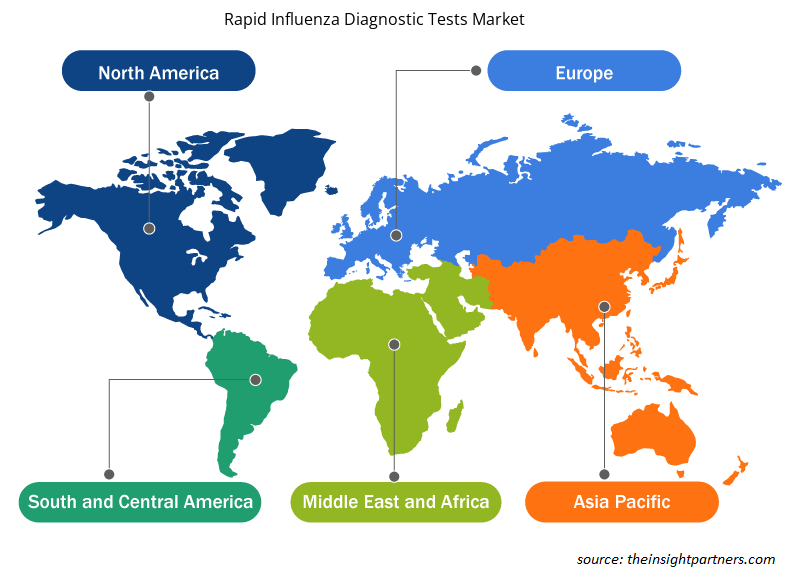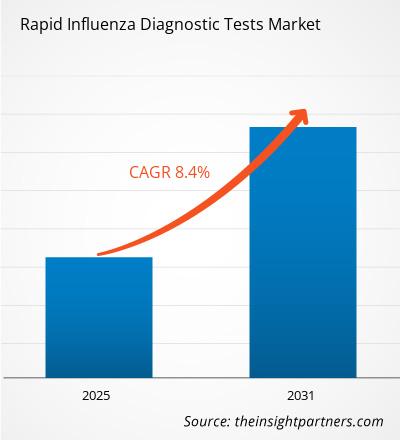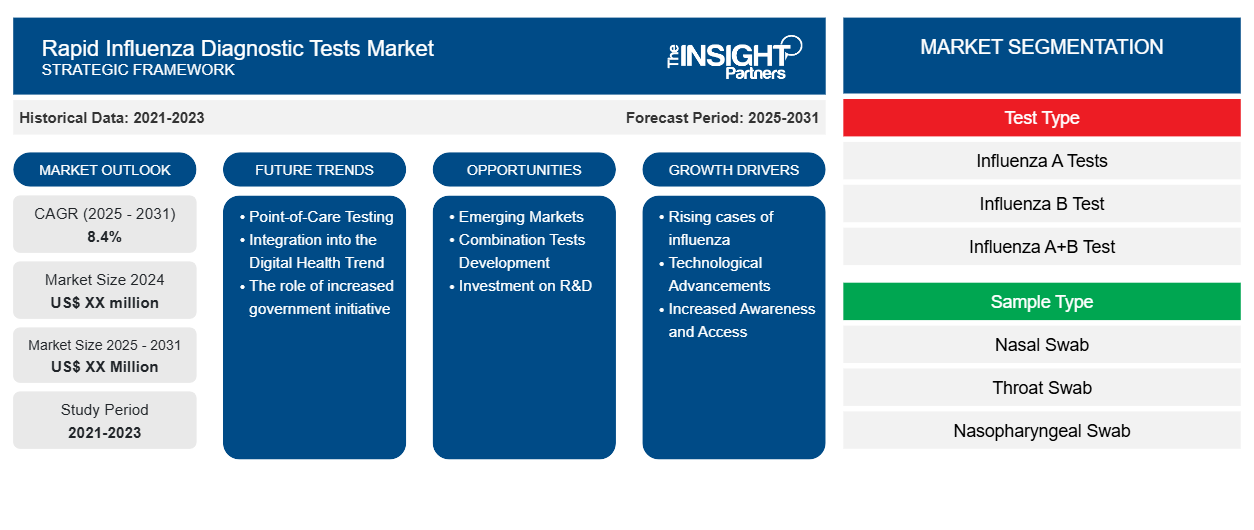迅速インフルエンザ診断検査市場は、2024年から2031年にかけて8.4%のCAGRで成長し、市場規模は2024年のXX百万米ドルから2031年にはXX百万米ドルに拡大すると予想されています。
レポートはタイプ別(油圧、手動、電子)にセグメント化されています。レポートではさらに、アプリケーション別(歯科技工所、病院、その他)の分析も示しています。グローバル分析は、地域レベルと主要国別にさらに細分化されています。レポートでは、上記の分析とセグメントの値をUSDで提供しています。
報告書の目的
The Insight Partners によるレポート「インフルエンザ迅速診断検査市場」は、現在の状況と将来の成長、主な推進要因、課題、機会を説明することを目的としています。これにより、次のようなさまざまなビジネス関係者に洞察が提供されます。
- テクノロジープロバイダー/メーカー: 進化する市場の動向を理解し、潜在的な成長機会を把握することで、情報に基づいた戦略的意思決定が可能になります。
- 投資家: 市場の成長率、市場の財務予測、バリュー チェーン全体に存在する機会に関する包括的な傾向分析を実施します。
- 規制機関: 市場の濫用を最小限に抑え、投資家の信用と信頼を維持し、市場の完全性と安定性を維持することを目的として、市場における政策と警察活動を規制します。
インフルエンザ迅速診断検査市場のセグメンテーション
テストの種類
- インフルエンザA検査
- インフルエンザB検査
- インフルエンザA+B検査
サンプルタイプ
- 鼻腔スワブ
- 咽頭ぬぐい液
- 鼻咽頭スワブ
- その他
テクノロジー
- 免疫クロマトグラフィーアッセイ
- 免疫蛍光アッセイ
- 核酸増幅検査
エンドユーザー
- 病院と診療所
- 診断センター
- 老人ホーム
- その他
要件に合わせてレポートをカスタマイズする
このレポートの一部、国レベルの分析、Excelデータパックなど、あらゆるレポートを無料でカスタマイズできます。また、スタートアップや大学向けのお得なオファーや割引もご利用いただけます。
- このレポートの主要な市場動向を入手してください。この無料サンプルには、市場動向から見積もりや予測に至るまでのデータ分析が含まれます。
インフルエンザ迅速診断検査市場の成長要因
- インフルエンザの症例の増加: インフルエンザ感染の蔓延、特に季節的な流行の増加により、迅速な診断検査の需要が高まっています。感染症の早期かつ効果的な治療も必要であり、そのため、迅速なインフルエンザ診断検査は、患者の転帰を改善し、臨床ワークフローを改善するために医療提供者が採用する重要なツールとなっています。
- 技術の進歩: 診断分野の発展、たとえば改良された使いやすいインフルエンザ迅速検査は、市場の成長を促進するのに役立っています。この進歩により、より迅速な結果が得られ、感度も向上し、臨床現場やポイントオブケアの現場では必須となり、ますます多くの医療専門家が参加しています。
- 認識とアクセスの向上: インフルエンザの早期診断の重要性について患者と医療提供者の認識が高まり、市場の成長の主な理由となっています。薬局やクリニックを通じたアクセスが拡大し、迅速な検査が保証されることで、検査が使用される可能性が高まり、インフルエンザの季節における公衆衛生の対応が強化されます。
インフルエンザ迅速診断検査市場の将来動向
- ポイントオブケア検査: インフルエンザの迅速診断検査市場は、ポイントオブケア検査で前進しています。利便性とスピードが医療提供者を POC 検査の採用へと駆り立て、即座に得られる結果によって治療の決定を即座に下せるようになり、臨床現場での患者ケアとリソース管理を改善できるようになりました。
- デジタルヘルストレンドへの統合: モバイルアプリケーションや遠隔医療などのデジタルヘルステクノロジーを駆使した迅速な診断テストの導入が進んでいます。これにより、データの管理が改善され、患者との医療相談の統合により遠隔相談が可能になり、インフルエンザの症例の監視が効率的になり、全体として医療サービスが強化され、患者の関心が高まります。
- 政府の取り組み強化の役割: 資金提供や啓発キャンペーンにおける政府の取り組み強化により、インフルエンザの迅速診断検査の利用が促進されます。このような取り組み強化により、インフルエンザの発生に対する監視と制御が強化され、すべての公共施設と民間施設でこれらの検査の開発と提供が促進されます。
インフルエンザ迅速診断検査の市場機会
- 新興市場: 新興市場では医療インフラが急速に成長しており、迅速なインフルエンザ診断検査の大きなチャンスが生まれています。医療の向上に向けた地域の投資が増えると、このような効果的な診断ツールの需要が高まり、メーカーが新しい市場や顧客に参入する余地が生まれます。
- 複合検査の開発: 複合検査により、製造業者はインフルエンザなどの呼吸器疾患の原因となる複数の病原体を同時に検出できる検査を考案できるようになります。したがって、このイノベーションは、呼吸器疾患の発生時に最も望まれる、広範かつ包括的な検査ソリューションを持つという医療提供者の問題を解決することになります。
- 研究開発への投資: 診断研究を目的とした新しい高度な技術は、研究開発への投資をさらに引き付けるでしょう。こうして、インフルエンザの季節に医療提供者がより良い公衆衛生管理を提供できるよう、精度、迅速な検出、検査結果の簡単な処理に重点を置き、迅速なインフルエンザ診断検査市場に新たな道を切り開くことができます。
インフルエンザ迅速診断検査市場の地域別分析
予測期間を通じて迅速インフルエンザ診断検査市場に影響を与える地域的な傾向と要因は、Insight Partners のアナリストによって徹底的に説明されています。このセクションでは、北米、ヨーロッパ、アジア太平洋、中東およびアフリカ、南米および中米にわたる迅速インフルエンザ診断検査市場のセグメントと地理についても説明します。

- インフルエンザ迅速診断検査市場の地域別データを入手
インフルエンザ迅速診断検査市場レポートの範囲
| レポート属性 | 詳細 |
|---|---|
| 2024年の市場規模 | XX百万米ドル |
| 2031年までの市場規模 | XX百万米ドル |
| 世界のCAGR(2025年~2031年) | 8.4% |
| 履歴データ | 2021-2023 |
| 予測期間 | 2025-2031 |
| 対象セグメント | テストの種類別
|
| 対象地域と国 | 北米
|
| 市場リーダーと主要企業プロフィール |
|
インフルエンザ迅速診断検査市場のプレーヤー密度:ビジネスダイナミクスへの影響を理解する
インフルエンザ迅速診断検査市場は、消費者の嗜好の変化、技術の進歩、製品の利点に対する認識の高まりなどの要因により、エンドユーザーの需要が高まり、急速に成長しています。需要が高まるにつれて、企業は提供を拡大し、消費者のニーズを満たすために革新し、新たなトレンドを活用し、市場の成長をさらに促進しています。
市場プレーヤー密度とは、特定の市場または業界内で活動している企業または会社の分布を指します。これは、特定の市場スペースに、その規模または総市場価値と比較して、どれだけの競合相手 (市場プレーヤー) が存在するかを示します。
迅速インフルエンザ診断検査市場で事業を展開している主要企業は次のとおりです。
- ディアソリン SpA
- ベクトン・ディキンソン・アンド・カンパニー
- SAサイエンティフィック
- コリスバイオコンセプト
- メリディアンバイオサイエンス株式会社
免責事項:上記の企業は、特定の順序でランク付けされていません。

- 迅速インフルエンザ診断検査市場のトップキープレーヤーの概要を入手
主なセールスポイント
- 包括的なカバレッジ: レポートでは、迅速インフルエンザ診断検査市場の製品、サービス、タイプ、エンドユーザーの分析を包括的にカバーし、全体的な展望を提供します。
- 専門家による分析: レポートは、業界の専門家とアナリストの深い理解に基づいてまとめられています。
- 最新情報: このレポートは、最新の情報とデータの傾向を網羅しているため、ビジネスの関連性を保証します。
- カスタマイズ オプション: このレポートは、特定のクライアント要件に対応し、ビジネス戦略に適切に適合するようにカスタマイズできます。
したがって、迅速インフルエンザ診断検査市場に関する調査レポートは、業界のシナリオと成長の見通しを解読し理解する道の先導役となる可能性があります。正当な懸念事項がいくつかあるかもしれませんが、このレポートの全体的な利点は欠点を上回る傾向があります。
- 過去2年間の分析、基準年、CAGRによる予測(7年間)
- PEST分析とSWOT分析
- 市場規模価値/数量 - 世界、地域、国
- 業界と競争環境
- Excel データセット
最新レポート
お客様の声
購入理由
- 情報に基づいた意思決定
- 市場動向の理解
- 競合分析
- 顧客インサイト
- 市場予測
- リスク軽減
- 戦略計画
- 投資の正当性
- 新興市場の特定
- マーケティング戦略の強化
- 業務効率の向上
- 規制動向への対応





















 無料サンプルを入手 - インフルエンザ迅速診断検査市場
無料サンプルを入手 - インフルエンザ迅速診断検査市場